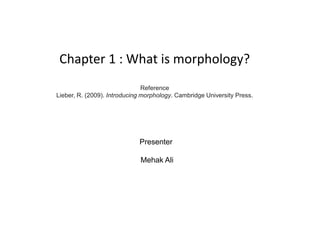
chapter 1.What is Morphology? (Morphology (Linguistics)
- 1. Chapter 1 : What is morphology? Reference Lieber, R. (2009). Introducing morphology. Cambridge University Press. Presenter Mehak Ali
- 2. What is morphology? • Morphology is the study of word formation, including the ways new words are coined in the languages of the world, and the way forms of words are varied depending on how they’re used in sentences. • As a native speaker of your language you have intuitive knowledge of how to form new words, and every day you recognize and understand new words that you’ve never heard before.
- 3. Your ability to make up these new words, and to make judgments about words that you think could never exist, suggests that you have intuitive knowledge of the principles of word formation in your language, even if you can’t articulate what they are.
- 4. What's a word? • Few specialized linguistic terms • morpheme as the smallest unit of language that has its own meaning. Simple words like giraffe, wiggle, or yellow are morphemes, but so are prefixes like re- and pre- and suffixes like -ize and -er. • word as one or more morphemes that can stand alone in a language. • Words that consist of only one morpheme, like the words in (1), can be termed simple or simplex words. Words that are made up of more than one morpheme, like the ones in (2), are called complex:
- 6. Words and lexemes, types and tokens • It’s useful to have some special terms for how we count words. • If we are counting every instance in which a word occurs in a sentence, regardless of whether that word has occurred before or not, we are counting word tokens. • If we count word tokens in the sentence above, we count 21. • If, however, we are counting a word once, no matter how many times it occurs in a sentence, we are counting word types. • Counting this way, we count 20 types in the sentence above: the two tokens of the word and count as one type.
- 7. • A still different way of counting words would be to count what are called lexemes. • Lexemes can be thought of as families of words that differ only in their grammatical endings or grammatical forms; singular and plural forms of a noun (class, classes), present, past, and participle forms of verbs (walk, walks, walked, walking), different forms of a pronoun (I, me, my, mine) each represent a single lexeme. • One way of thinking about lexemes is that they are the basis of dictionary entries; dictionaries typically have a single entry for each lexeme. • the sentence then has 16 lexemes
- 8. But is it really a word? • If it consists of morphemes, has a meaning, and can stand alone, doesn’t it qualify as a word according to our definition even if it doesn’t appear in the dictionary? • What all these questions suggest is that we each have a mental lexicon, a sort of internalized dictionary that contains an enormous number of words that we can produce, or at least understand when we hear them. But we also have a set of word formation rules which allows us to create new words and understand new words when we encounter them. • In the chapter to follow we will explore the mental lexicon etc.
- 9. Why do languages have morphology? • One reason for having morphology is to form new lexemes from old ones. • Lexeme formation can do one of three things. • It can change the part of speech (or category) of a word, for example, turning verbs into nouns or adjectives, or nouns into adjectives, as you can see in the examples in (3):
- 10. • Some rules of lexeme formation do not change category, but they do add substantial new meaning: • And some rules of lexeme formation both change category and add substantial new meaning:
- 11. Why have rules of lexeme formation? • Imagine what it would be like to have to invent a wholly new word to express every single new concept. • As you can see, rules of lexeme formation allow for a measure of economy in our mental lexicons: we can recycle parts, as it were, to come up with new words. • It is probably safe to say that all languages have some ways of forming new lexemes.
- 12. • On the other hand, we sometimes use morphology even when we don’t need new lexemes. • When we change the form of a word so that it fits in a particular grammatical context, we are concerned with what linguists call inflection. • Inflectional word formation is word formation that expresses grammatical distinctions like number (singular vs. plural); tense (present vs. past); person (first, second, or third); and case (subject, object, possessive), among others. • It does not result in the creation of new lexemes, but merely changes the grammatical form of lexemes to fit into different grammatical contexts.
- 13. • We create different forms of nouns according to number (wombat, wombats); we mark the possessive form of a noun with -’s or -s’ (the wombat’s eyes).We have different forms of verbs for present and past and for present and past participles (sing, sang, singing, sung), and we use a suffix -s to mark the third person singular of a verb (she sings). • Summary • Morphology is the study of words and word formation. In this chapter we have considered what a word is and looked at the distinction between word tokens, word types, and lexemes. We have divided word formation into derivation - the formation of new lexemes - and inflection, the different grammatical word forms that make up lexemes.